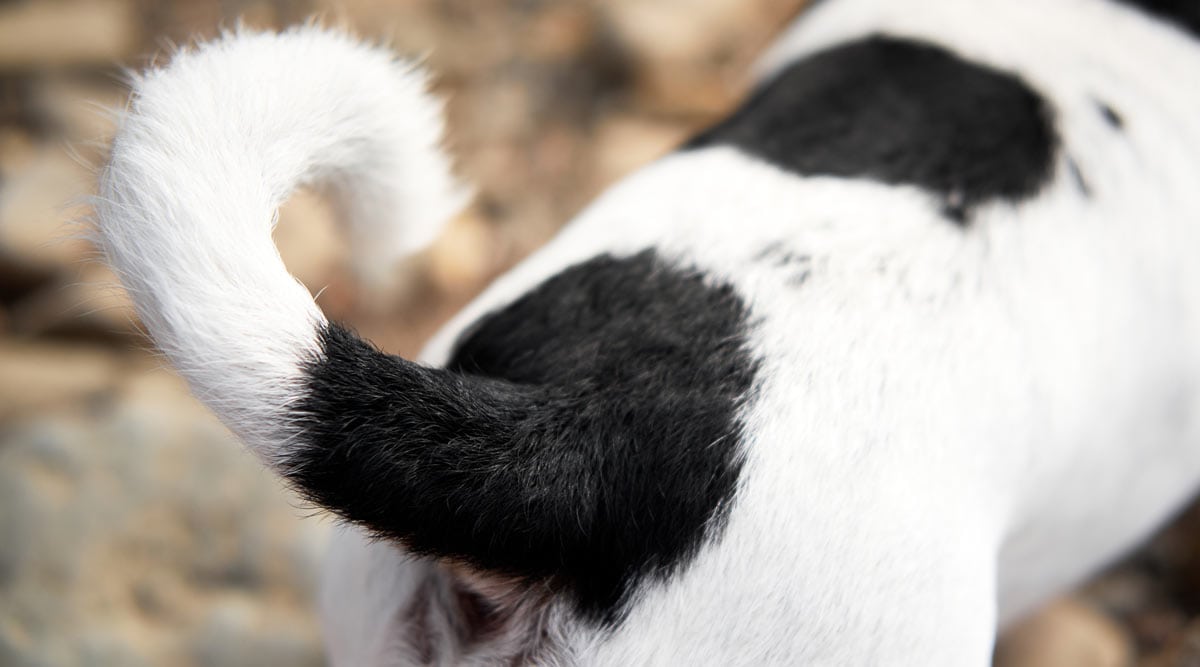Does your dog suddenly have a limp tail that’s stopped wagging? If so, they could have limber tail syndrome, a painful condition involving overused, sprained, or damaged tail muscles.
Fortunately, limber tail syndrome usually gets better within a week. However, you should still visit a vet if you notice your dog’s tail hanging limply, as this could be caused by other medical conditions.
In this article, we’ll discuss limber tail syndrome in dogs, including symptoms, causes, and treatments. We’ll also share some prevention tips to keep your dog’s tail wagging!
Contents

Key Takeaways
- Limber tail syndrome, or acute caudal myopathy, is a condition causing a dog’s tail to hang limp.
- It’s often triggered by intense exercise, swimming in cold water, or weather changes.
- While any dog can suffer from limber tail, it’s particularly common in larger working breeds.
- A thorough examination by a vet is crucial to rule out other serious causes of a limp tail.
- Treatment involves rest, pain management, and heat therapy. Most dogs recover fully within a week.
What Is Limber Tail Syndrome?
A limp or flaccid tail that can’t wag could be a sign of limber tail syndrome, more formally known as acute caudal myopathy.
Despite ongoing research, vets are still uncertain about the exact cause of limber tail syndrome. However, it’s believed to occur due to overuse or strain on the tail muscles. It could also be caused by the tail being held in an unnatural position for an extended time.
While limber tail syndrome is usually a temporary condition, it shouldn’t be ignored. Limber tail can cause intense pain and distress for our furry friends, so a vet visit is essential.
Is Limber Tail a True Medical Condition?
Yes, limber tail syndrome is a genuine medical condition. “Limber tail” is its slang name though – vets call it acute caudal myopathy. You may also hear this condition called other names, such as such as limp tail, swimmer’s tail, dead tail, or cold water tail.
What Causes Limber Tail Syndrome in Dogs?
While this condition is poorly understood, limber tail syndrome is probably caused by muscle strain or overuse. It may also be triggered by a lack of adequate blood supply to the tail muscles.
More specifically, limber tail is often associated with:
- High-intensity exercise or overexertion, particularly if the dog isn’t accustomed to such vigorous activity
- Swimming, especially in cold water, hence the term “cold water tail”
- Exposure to cold weather
- Confinement in a crate for an extended period, especially if the tail is forced into an awkward position
- Significant changes in weather or climate
Of these potential triggers, swimming is one of the most common cause of limber tail. This is probably because it involves both intense use of the tail muscles (which act as a rudder) and exposure to cold.
Walking in cold weather is also a risk factor for limber tail. “I see most cases after the first snowfall of the season, when a dog has been out walking and their tail has gotten very cold,” says vet Dr. Linda Simon. “Anecdotally, I always see more Labrador Retrievers affected vs any other breed.”
The first symptoms of limber tail usually appear within 24 hours of the triggering activity. This means that your dog may not show any signs of discomfort until the day after the event.
Interestingly, a recent study indicated that dogs residing at higher latitudes are more likely to develop limber tail syndrome. This suggests a genetic predisposition to the condition.
Why Working Dogs Are at Greater Risk
Any dog can suffer from limber tail syndrome, but it’s most commonly seen in larger working breeds. Why is this the case?
Working dogs like Labrador Retrievers, Foxhounds, Beagles, and Pointers heavily rely on their tails for balance during their physical activities. These breeds are also more likely to participate in activities associated with limber tail syndrome, such as swimming and intense physical exertion.
What Are the Symptoms?
The most noticeable symptom of limber tail is a limp tail that’s unable to wag.
However, the appearance of the tail can vary. In some dogs, the tail might droop entirely between the back legs. In other dogs, the tail might stick out horizontally a few inches before hanging down. Either way, the tail won’t be able to wag properly and will remain limp even when the dog moves.
Other symptoms of limber tail syndrome include:
- Difficulty getting up or walking due to the tail’s role in balance
- Inability to rest or settle due to pain
- The urge to chew the base of the tail
- Hair standing up at the base of the tail
- Swelling or tenderness at the base of the tail
- Signs of pain such as whimpering or whining
- Changes in behavior or eating patterns due to discomfort
- Difficulty going to the bathroom due to pain
Keep in mind that a dog’s tail is essential for communication. So, when your pet has limber tail, they may struggle to communicate as clearly with other dogs.
Related: Why Do Dogs Wag Their Tails? The Truth Behind Wagging
How Do Vets Diagnose Limber Tail?
While the signs of limber tail syndrome might seem obvious, it’s essential for a vet to rule out other, potentially more serious causes of a limp tail. So, if your pooch shows signs of a limp tail, it’s best to schedule a vet visit as soon as possible.
Diagnosis typically combines a review of the dog’s history, recent activities, and a thorough physical examination. This includes an in-depth examination of the tail, starting at the base. The vet will palpitate the tail, checking for signs of tenderness, swelling, or even a fracture.
While not always necessary, diagnostic tests such as X-rays or MRIs may be needed to rule out tail fractures or spinal issues.
Additionally, the vet may check and empty (if required) the anal glands. Many dogs hold their tail close to their body when they have an anal gland impaction or infection, which can mimic some of the symptoms of limber tail.
Treatment for Limber Tail in Dogs
Limber tail can often resolve without treatment, but there are a few ways to make the process faster and less painful for your pet.
Rest is the most important treatment for limber tail. Just like with any muscle injury, the tail needs a break from vigorous activity to heal. Gentle heat therapy applied to the base of the tail can also bring relief and speed up the healing process.
Keep in mind that limber tail can be a very painful condition for dogs. It might prevent your pet from performing basic activities, such as resting, toileting, or sitting.
For this reason, it’s essential to visit a vet if you notice symptoms of limber tail. They may prescribe medications, such as the NSAID Meloxicam, to alleviate pain and reduce inflammation while your dog is recovering.
Additionally, if your dog usually spends time in a crate, ensure it’s big enough for your pet. A cramped tail position or limited blood flow could make the condition worse.
Finally, try to keep your dog calm and avoid exciting situations (such as guests or playing with other dogs). It’s impossible for your dog to avoid trying to wag their tail when excited, which can delay the healing process.
Important: Never give your dog medication without a vet’s approval. Some medications could cause side effects or interact with other medications your dog might be taking.

Can Limber Tail Be Treated at Home?
While limber tail often improves with rest, it’s always a good idea to consult with a vet.
Remember, a limp tail can also indicate several other conditions – some of which require immediate veterinary intervention. So, to ensure your pooch gets the best care possible, never skip a vet visit if you notice their tail going limp.
What Is the Long-Term Outlook for a Dog with Limber Tail?
The good news is that most dogs recover from limber tail syndrome within 3-7 days. The time for recovery varies depending on the dog, the severity of the condition, and whether the tail is given sufficient rest.
Unfortunately, limber tail can recur in some dogs. However, a study found that less than 50% of dogs experience a recurrence (source), so there’s a good chance that limber tail is a one-off issue.
Preventing Limber Tail
As we’ve mentioned, limber tail usually heals relatively quickly, and most dogs make a full recovery. Additionally, many dogs can take part in the same activities in the future without triggering a new bout of limber tail.
Even so, there are a few things you can do to reduce the chance of a recurrence of limber tail:
- Allow your dog time to warm up your dog before vigorous exercise.
- Steer clear of prolonged exposure to cold water and chilly weather.
- Avoid sudden increases in exercise intensity or duration. Like with humans, your dog’s fitness should be built up slowly.
- Regular, moderate exercise may help to strengthen the tail muscles.
- Ensure your dog’s crate is roomy enough so its tail muscles aren’t cramped. This applies to both home crates and car crates.
Other Conditions That Can Look Similar to Limber Tail
While limber tail syndrome is fairly common, it’s not the only medical problem that can produce a limp tail.
This is why a veterinary examination is essential. While limber tail often gets better on its own, there are more serious medical problems that can mimic its symptoms.
Here are some conditions that might also lead to a limp tail:
- Fractures or other physical injuries to the tail.
- Prostatitis in male dogs, which can cause discomfort around the tail base.
- Anal gland infections, resulting in tail discomfort.
- Intervertebral disc disease.
- Arthritis.
“Keep in mind that dogs often experience more intense flare-ups of their arthritis symptoms when the weather is cold,” adds Dr. Linda Simon. “I find many owners assume a dog with a limp tail who has been swimming in cold water or who has been out in the snow has limber tail, but this will not always be the case.”
So, if your pooch’s tail goes limp, don’t play the guessing game. Consult a vet to get an accurate diagnosis and treatment.
Frequently Asked Questions
In most cases, dogs with limber tail syndrome show significant improvement within 3-7 days. However, it can take a bit longer in some cases.
Yes, limber tail is a painful condition that can be very uncomfortable for your dog. The pain can cause behavior changes, difficulty sitting or resting, and a reluctance to go to the toilet.
With sufficient rest, limber tail often heals on its own. But the pain and inflammation caused by limber tail can be significant, so you really should seek veterinary care. A vet can also rule out other conditions that might cause similar symptoms.
Any dog can suffer from limber tail. But there are risk factors that make the condition more likely in some dogs. Dogs most at risk include working breeds, hunting dogs, large breeds, and those that live in northern latitudes.
Summary
If your dog’s tail suddenly droops and stops wagging, you may be dealing with limber tail syndrome. This is an uncomfortable condition that’s thought to be caused by strained tail muscles or lack of blood flow.
Fortunately, most dogs heal within a week – assuming that the tail is given time to recover. However, heat therapy and pain-killing medication may also be required to manage your dog’s symptoms, so a vet checkup is essential. Your veterinarian will also check for conditions that can cause similar symptoms, such as a tail fracture or arthritis.
Do you have any questions about limber tail syndrome in dogs? Please let us know in the comments section below. You may also want to read our guide to happy tail syndrome.




